|
< Earlier Kibitzing · PAGE 2 OF 2 ·
Later Kibitzing> |
| Mar-14-09 | | apoka: A very interesting position! I saw ♘xb5, but did not take the time to compute the variations after it (which would have been quite difficult). Doing a deep multi variant analysis with Toga II (two billion positions) up to depth 17, it comes up with the following 5 most promising moves: 1. ♘xb5 +4.64 (20...cxb5 21.♕xc8+ ♘xc8 22.♖xc8+ ♔d7 23.♖fc1 ♕c4) 2. axb5 +3.57 (20...cxb5 21.♕e2 ♖b8 22.♗g3 ♕xd4+ 23.♔h1 ♔d8) 3. ♖fe1 +2.84 (20...bxa4 21.♘xa4 h5 22.♗a6 ♖c7 23.♘c5 ♘d5) 4. ♖a1 +2.73 (20...♔d8 21.♖a3 bxa4 22.♖xa4 ♕b6 23.d5 c5) 5. ♖fd1 +2.59 (20...bxa4 21.♘xa4 ♘d5 22.♗a6 ♖c7 23.♖e1 ♕b8) The means that the simple axb5 and the ♖fe1 mentioned in other posts are also winning, but they are surely not as nice as the Knight sac. |
|
| Mar-14-09 | | YoungEd: I got the first three moves and then didn't see it through. Some of you in the same boat are disappointed, but for me partial credit is a huge victory! :) |
|
| Mar-14-09 | | whiteshark: I remembered this first win in 1st round. |
|
| Mar-14-09 | | agb2002: Material is roughly even (White has the bishop pair) but Black's development is so poor that White looks like being two or three pieces ahead. The black king is in the center and the queen doesn't have any square to move. This suggests trying to trap her with 20.Na2 Qxa4 21.b3 Qa3 but the square d6 would be available after the knight moves. Another possibility is 20.Nxb5 followed by Be1 and b3 but the rook on c8 threatens the white queen. However, 20.Nxb5 opens the position to attack the black king: A) 20... Nxb5 21.Bxb5  , followed by Bxc6 (21... cxb5 22.Qxc8#). , followed by Bxc6 (21... cxb5 22.Qxc8#). B) 20... cxb5 21.Qxc8+ (21.Bxb5+ Qxb5) Nxc8 22.Rxc8+ Kd7 23.Rfc1 B.1) 23... Qxa4 24.R1c7+ Kd6 25.Bg3+ e5 (25... Kd5 26.Rd8+ Nd7 27.Rdxd7#) 26.exd5+ Kd5 27.Rd8+ and mate in two. B.2) 23... bxa4 24.R1c7+ Kd6 25.Bg3+ Kd5 (25... e5 26.exd5+ Kd5 27.Rd8+ Bd6 28.Rxd6+ Qxd6 29.exd6  ) 26.Rd8+ Qd6 27.Bxd6 exd6 28.Rcc8 Nh7 29.Nc4+ Kxd4 30.Bxf7 ) 26.Rd8+ Qd6 27.Bxd6 exd6 28.Rcc8 Nh7 29.Nc4+ Kxd4 30.Bxf7  . . B.3) 23... Nd5 24.Bxb5+ Kd6 (24... Qxb5 25.axb5  ) 25.R1c6+ Kd7 26.R6c7+ Kd6 27.Rd7#. ) 25.R1c6+ Kd7 26.R6c7+ Kd6 27.Rd7#. B.4) 23... e5 24.Bxb5+
B.4.a) 24... Qxb5 25.axb5  . .
B.4.b) 24... Ke7 25.dxe5 Nd7 26.Bc5+ Qxc5 (26... Nxc5 27.Re8#) 27.R1xc5  . . B.4.c) 24... Kd6 25.R1c6+ Ke7 (25... Kd5 26.Bc4+  ; 25... Kd7 26.dxe5 ; 25... Kd7 26.dxe5  ) 26.dxe5 Nd7 27.R6c7 ) 26.dxe5 Nd7 27.R6c7  . . B.5) 23... e6 is similar to B.2.
B.6) 23... Kd6 24.Rd8+ Nd7 25.Bxb5  . .
B.7) 23... Qd6 24.Bxb5+  . .
B.8) 23... Ne8 24.Bxb5+ Qxb5 (24... Kd6 25.Rd8#) 25.axb5  . . Time to check.
|
|
| Mar-14-09 | | agb2002: I am perplexed with my comment 'B.5) 23... e6 is similar to B.2.': 1. After 23... e6 one can play 24.Bxb5+, as in the game, but after 23... bxa4 24.Bxb5+ is met with 24... Qxb5. 2. The maneuver in B.2, 24.R1c7+ Kd6 25.Bg3+ Kd5 26.Rd8+ is now met with 26... Bd6 because the pawn moved from e7. Anyway, not too bad, in spite of this hallucination. |
|
| Mar-14-09 | | patzer2: For today's difficult Saturday puzzle solution, White plays 20. Nxd5!! which prepares to sacrifice the Queen to initiate a winning minor piece pursuit (King Hunt) combination. The key to solving today's puzzle (20. ?) is seeing that the somewhat quiet waiting move 23. Rfc1! creates decisive threats. For example, if 23...bxa4, then White mates after 24. R1c7+ Kd6 25. Bg3+ Kd5 26. Rd8+ Nd7 (26... Qd6 27. Be5 Qxd8 28. Bc4#) 27. Rdxd7+ Qd6 28. Be5 Qxd7 29. Bc4#. P.S.: A good illustrative example of a Zwischenzug (a.k.a. intermezzo) or "in between move" is 29. Bc4+!, which interrupts the expected capture of the Queen with a key deflection to remove the King as a defender and leave White a decisive piece up at the end of the combination. |
|
| Mar-14-09 | | outplayer: I saw 20.Nxb5! but haven't calculated the variation to the end. A pity. |
|
| Mar-14-09 | | johnlspouge: Saturday (Very Difficult)
Zhao Xue vs Yang Shen, 2009 (20.?) White to play and win.
Material: B for N. The Black Ke8 has 2 legal moves and is on a semi-open file. The Qb4 has no flight squares. White has a battery pinning Pc6 to Rc8 after he moves Nc3, so the Black Nd6 has some burden protecting Rc8. Without Nd6, the Black Nf6 also has some burden to prevent Nc3-d5, which would fork Qb4 after Nc3-d5…Qb4xa4 Nd5-b6. White cannot immediately deflect either Nd6 or Nf6, however. The Black K-side has appalling development, so White should open the game immediately to exploit his lead in development. The positional candidate 20.d5, which activates Bf2 by opening the a7-g1 diagonal, should therefore be examined deeply. The White Kg1 is secure from checks. Candidates (20.): d5
I went for 20.d5, an extremely bad case of being too attracted to a single candidate. The move 20.Nxb5 opens the game much more positionally, because it exploits the pin on the c-file, rather than trying to counter-punch through Rxc2. |
|
| Mar-14-09 | | CHESSTTCAMPS: I spent most of the first 5 minutes attempting to trap the black queen. Then the right idea jumped out at me: 20.Nxb5!
Intending to sacrifice queen for rook to expose the black king. The logic of this sacrifice is evident: Without the undeveloped rook and bishop, black is effectively way behind in material, so white's rooks and bishops should dominate. 20.... cxb5
Black has no good alternatives. After 20...Nxb5 21.Bxb5, black's pawn on c6 is pinned and there is no good defense against Bxc6+. Also, black does not have time to concede the pawn and belatedly attempt castling, e.g. 21...g6 22.Bd1 traps the black queen, forcing 22...cxb5 23.Qxc8+ Nxc8 24.Bxb4 axb4 25.Rxc8+ Kd7 26.Rb8 with an exchange up and an easy win after cleaning up black's queenside pawns. 21.Qxc8+ Nxc8
22.Rxc8+ Kd7
23.Rfc1
There are too many threats to defend. Each of the following tries ends in a quick win for white: A 23...bxa4 (to defend b5) 24.R1c7+ Kd6 25.Bg3+ e5 (or 25...Kd5 26.Rd8+ Qd6 27.Bxd6 exd6 28.R7c8 cleans up) 26.dxe5+ Kd5 27.Rd8+ Bd6 28.Rxd8 winning the queen and finishing a piece ahead. B 23...Qd6 (to defend c7) 24 Bxb5+ wins the queen with mate to follow soon. C 23...Nd5 24.Bxb5+ Kd6 25.Bg3+ Nf4 (or e5 26.Bxe5+) 26.Bxf4+ Kd5 27.Rd8+ Qd6 (a nice mate in two problem) 28.Be5! Qd8 29.Bc6# D 23...Kd6 24.Bg3+ e5 (24...Kd7 25.R1c7# and 24...Kd5 25.Rd8+ Qd6 26.Bxd6 exd6 27.R1c8 is like variation A) 25.dxe5+ Kd5 26.Rd8+ Bd6 27.Rxd6+ wins the queen as in variation A E 23...e5 24.Bxb5+ Kd6 25.R1c6+ Ke7 (or Kd5 26.Bc4+ wins the queen) 26.dxe5! Nd7 27.R6c7 wins Time to see how the game went. |
|
| Mar-14-09 | | patzer2: Of course after 29. Bc4+! Kxd4 30. Bxd6 Ne8 31. Rc8 Nxd6 32. Rxh8 Kxc4 33. fxe6 fxe6 34. Rg8 Nf5 35. Kf2 g5 36. Rg6 Kd5 37. g4 Nd4 38. Rxh6  , White is technically only an exchange and two pawns up (and not the piece up I previously stated). Yet with more than the equivalent of a piece up, it's an easy win. , White is technically only an exchange and two pawns up (and not the piece up I previously stated). Yet with more than the equivalent of a piece up, it's an easy win.Interesting is the alternative 29. Bxd6 (in lieu of the intermezzo 29. Bc4+! as played in the game) 29...Kxd6 30. Rxf7 exf5 (30...Rg8 31. fxe6! Kxe6 32. Bc4+ Kd6 33. Rxf6 gxf6 34. Bxg8  ) 31. Rxg7 ) 31. Rxg7  , when White is still up enough material (three pawns plus) to force immediate resignation. , when White is still up enough material (three pawns plus) to force immediate resignation. |
|
Mar-14-09
 | | Jimfromprovidence: I saw black's best defense as 20...Nd5.
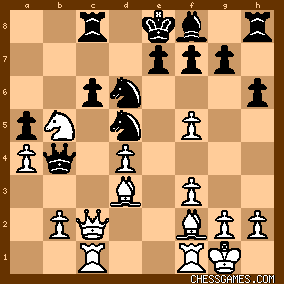
click for larger view Now, 21 Na7 Rc7 22 Nxc6 picks up two pawns.
Black is still not in good shape but white has more work to do. |
|
| Mar-14-09 | | CHESSTTCAMPS: <<Jimfromprovidence:> wrote I saw black's best defense as 20...Nd5.
Now, 21 Na7 Rc7 22 Nxc6 picks up two pawns. > But what about 21.Be1 trapping black's queen? If 21...cxb5 22.Qxc8+ Nxc8 23.Bxb4 Nxb4 24.Rxc8+ Kd7 25.Rc3 leaves white a rook ahead. See my initial post.
|
|
| Mar-14-09 | | TheChessGuy: Got it, somehow. My "chief variation" led to doubling rooks on the c-file, which I felt gave a strong enough attack to compensate for the queen. I also calculated, after 24.Bxb5+, that 24...Qxb5?! 25.R1c7+ Kd6 26.Bg3+ Kd5 27.Rc5+ regains the queen for the bishop, giving White good winning chances with connected passed pawns on the a- and b-files (after Rxa5). The fact that Black's back rank is so weak is just a cherry on top. Good puzzle! |
|
| Mar-14-09 | | SpoiltVictorianChild: Saw the idea, but couldn't make anything definitive come of the queen sac. |
|
| Mar-14-09 | | WhiteRook48: too hard for me |
|
Mar-14-09
 | | Jimfromprovidence: <CHESSTTCAMPS> <But what about 21.Be1 trapping black's queen? If 21...cxb5 22.Qxc8+ Nxc8 23.Bxb4 Nxb4 24.Rxc8+ Kd7 25.Rc3 leaves white a rook ahead.> Nice one. Completely missed it.
Black can harrass white's queen for a bit after 21...Nxb5 Bxb4 then 22...Nxb4, but ultimately can't trap it. 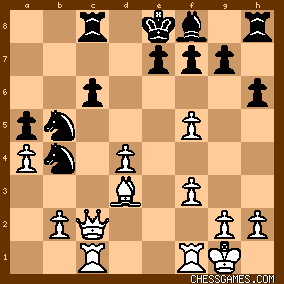
click for larger view |
|
| Mar-14-09 | | CHESSTTCAMPS: <Jimfromprovidence:> wrote <Nice one. Completely missed it. Black can harrass white's queen for a bit after 21...Nxb5 Bxb4 then 22...Nxb4, but ultimately can't trap it.> Right. As a side note from the first position you presented, after 21. Be1, I missed the fact that black can save the queen with the move 21...Ne3: 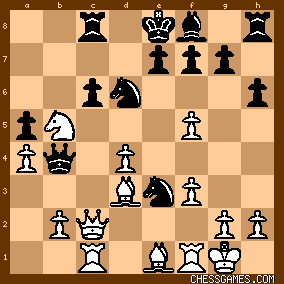
click for larger viewHowever, white still wins easily after 22.Qe2 Qxa4 23.Nxd6+ exd6 24.Qxe3+ |
|
| Mar-14-09 | | CHESSTTCAMPS: Here is a pretty "Mate in Two" puzzle that arises as a possible continuation from today's puzzle position.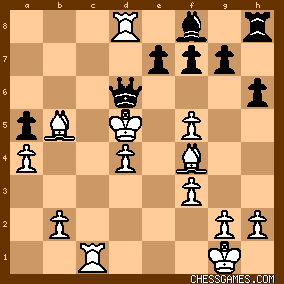
click for larger viewThis will be easy for the advanced players on this site and it has two solutions, so it wouldn't meet problemist standards. If you're stumped, go to my initial post, variation C. |
|
| Mar-14-09 | | thegoodanarchist: Black should have castled before commencing his wing attack |
|
| Mar-14-09 | | Samagonka: It's been a long time since I saw such a beautiful mate. Never came an inch close to the solution. |
|
| Mar-14-09 | | CHESSTTCAMPS: <<patzer2:> wrote< <Chessttcamps> Which of the two White Kings are we supposed to mate?> Well, that was sloppy editing - I guess I can't blame that on my glasses! Actually, I recall that I made a couple of errors that were trapped by the FEN editor. When I finally got a diagram to come up, I didn't take a really close look at it! OK let's try again.
White to play and mate in two:
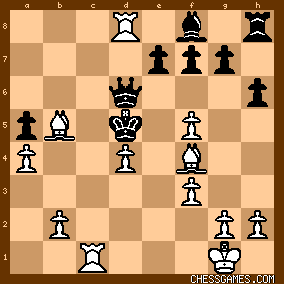
click for larger view |
|
| Mar-14-09 | | njchess: After looking at this position for a few minutes, the hanging c pawn is Black's weak point. Considering he hasn't castled yet, any attack along the c-file will be tough to stop. It will mean a queen sacrifice for White, but it should be worth it. I found a nearly entirely forced line in 20. Nxb5! cxb5 21. QxR+ NxR 22. RxN+ Kd7 23. Rfc1 e6 (best?) 24. Bxb5+ Kd6 25. Bg3+ Kd5 26. Rd8+ Bd6 27 Rxd6+  |
|
| Mar-14-09 | | patzer2: <CHESSTTCAMPS> My guess is Be5! with the threat of Bc6# to follow. However, I can't find your other mate in two. |
|
| Mar-17-09 | | CHESSTTCAMPS: <patzer2:> wrote: <My guess is Be5! with the threat of Bc6# to follow. However, I can't find your other mate in two.> Be5! is the correct first move for both solutions, but Rc5# also works just as well as Bc6# for the 2nd move. |
|
| Feb-16-21 | | Saniyat24: *Istanbul...! |
|
 |
|
< Earlier Kibitzing · PAGE 2 OF 2 ·
Later Kibitzing> |





































